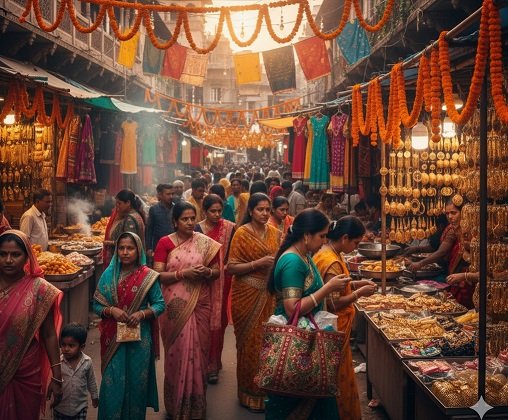Last Updated on October 4, 2025 12:28 am by BIZNAMA NEWS
R. Suryamurthy
India recorded its highest Navratri sales in more than a decade, with consumer demand surging across automobiles, electronics, and lifestyle goods, as recent tax reforms and a growing preference for domestic products lifted festive sentiment.
Industry players and trade bodies reported sales growth ranging between 25% and 100% during the nine-day festival, crediting the government’s cuts in Goods and Services Tax (GST) rates for lowering prices and expanding access to aspirational products. The surge comes at the start of the month-long Diwali season, with traders projecting record sales of ₹4.75 lakh crore this year — up from ₹4.25 lakh crore in 2024.
Auto sector leads the charge
Carmaker Maruti Suzuki posted its best-ever Navratri sales in at least a decade, doubling year-on-year volumes. The company reported 150,000 bookings and expects to reach 200,000, with 1.65 lakh deliveries in just eight days. On the first day alone, Maruti delivered 30,000 cars, marking its strongest single-day performance in 35 years.
SUV maker Mahindra & Mahindra saw retail sales rise 60%, while Hyundai reported SUVs accounting for over 72% of total sales, driven by Creta and Venue models. Tata Motors retailed more than 50,000 vehicles, led by demand for the Altroz, Punch, Nexon, and Tiago. Two-wheeler leader Hero MotoCorp reported a doubling of showroom footfalls, and Bajaj Auto also logged strong sales momentum.
Consumer electronics boom
Festive demand also buoyed the electronics sector. Haier saw sales soar 85%, nearly exhausting its Diwali stock of large-screen TVs, while LG and Godrej Appliances reported double-digit growth. Reliance Retail posted a 20–25% increase, led by smartphones, fashion, and TVs, while Vijay Sales also reported sales growth above 20%.
Traders eye record Diwali season
The Confederation of All India Traders (CAIT) projected Diwali sales to cross ₹4.75 lakh crore, citing both tax reforms and Prime Minister Narendra Modi’s call for “Vocal for Local – Local for Global” as key drivers. CAIT’s survey of 35 cities found strong consumer preference for Indian-made goods across categories ranging from clay lamps and handicrafts to automobiles, electronics, and FMCG products.
“Every rupee spent on Indian goods this Diwali strengthens the economy, generates jobs, and fulfills the vision of a self-reliant India,” said CAIT Secretary General and MP Praveen Khandelwal at a press conference in New Delhi. He described this year’s festival as “Apni Diwali – Bharatiya Diwali”, underscoring the growing Swadeshi sentiment.
Chinese imports sidelined
The shift away from Chinese goods — a trend that has gathered momentum since the 2020 Galwan Valley clash — has intensified, with traders saying Diwali markets this year are dominated by Indian-made products. Categories such as home décor, textiles, toys, and puja items are seeing a surge in demand for Swadeshi alternatives.
A consumption-driven boost
The festive calendar, stretching from Navratri through Diwali and Chhath Puja, accounts for 40–45% of annual retail sales. This year’s record numbers signal a broader boost for India’s consumption-driven economy at a time when global growth remains uncertain.
Economists say GST rationalisation, combined with pent-up demand and a cultural shift toward local goods, has amplified consumer confidence. With decorated bazaars, swelling footfalls, and record order books, India’s 2025 festive season appears set to cement its place as both a celebration of tradition and a showcase of economic momentum.

